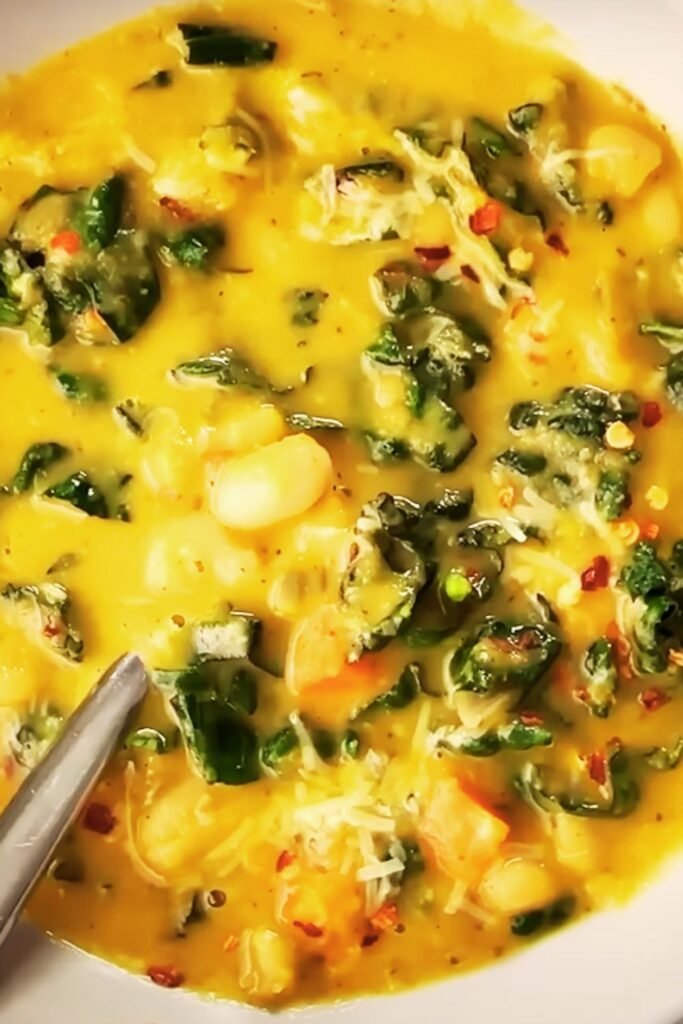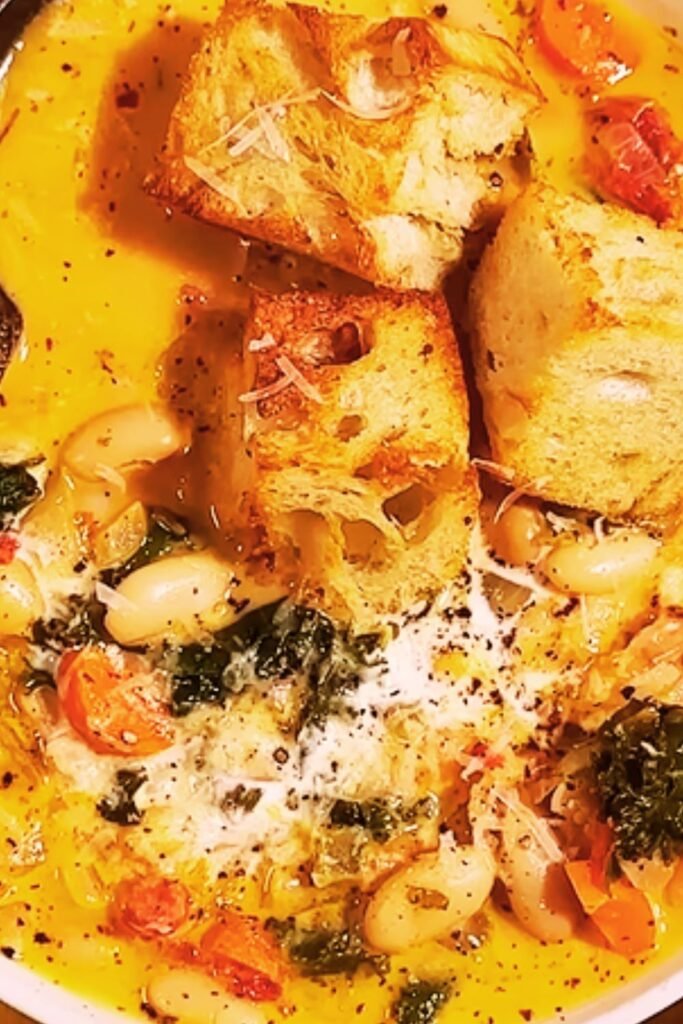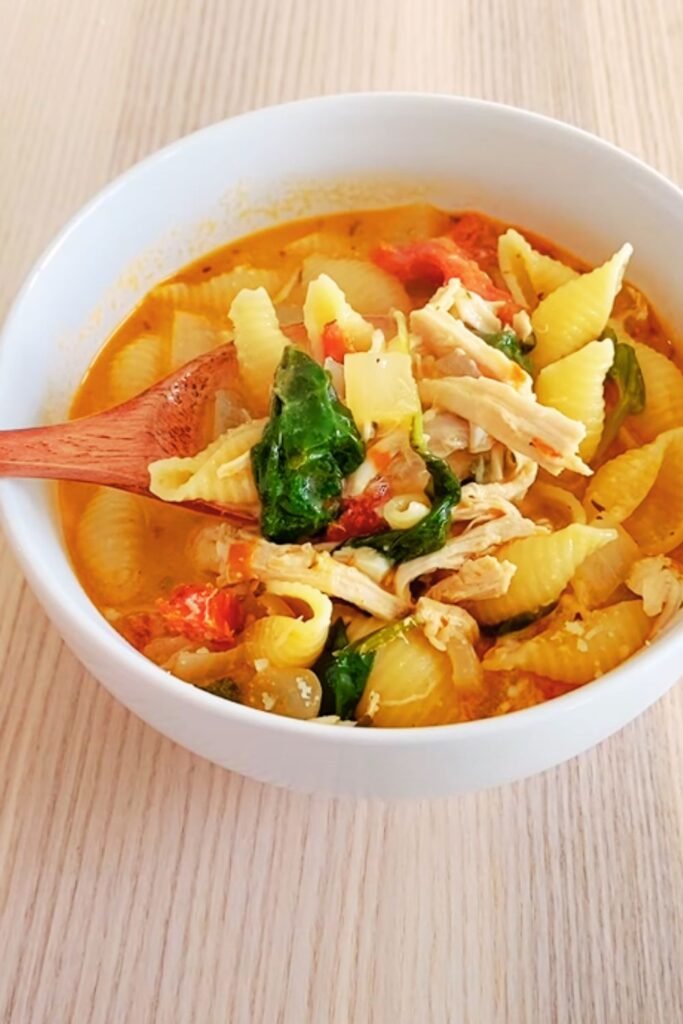I’ve been making Tuscan chicken soup for over a decade, and let me tell you, this isn’t just another soup recipe. This is the kind of dish that transforms your kitchen into a cozy Italian trattoria, filling every corner with aromas that make your neighbors knock on your door asking what smells so incredible.
When I first discovered this recipe during a trip to Florence, I was sitting in a small family-owned restaurant tucked away from the tourist crowds. The owner’s grandmother emerged from the kitchen, wiped her flour-dusted hands on her apron, and served me a bowl that changed everything I thought I knew about chicken soup. That creamy, herb-infused broth studded with tender vegetables and perfectly seasoned chicken became my obsession.
What Makes Tuscan Chicken Soup Special
Unlike traditional American chicken soup, Tuscan chicken soup embraces the rich culinary traditions of Tuscany with its distinctive blend of fresh herbs, creamy texture, and robust flavors. This soup represents the perfect marriage of rustic Italian cooking and sophisticated flavor profiles that have been passed down through generations.
The magic lies in the combination of fresh thyme, rosemary, and sage – herbs that grow wild on Tuscan hillsides and infuse the soup with an earthy, aromatic quality that’s impossible to replicate with dried alternatives. The addition of heavy cream creates a luxurious texture that coats each spoonful, while white beans add substance and authentic Italian character.
Key Characteristics of Authentic Tuscan Chicken Soup
Creamy Base: Unlike clear chicken broths, Tuscan chicken soup features a rich, creamy foundation that creates a satisfying, restaurant-quality texture.
Fresh Herb Profile: The holy trinity of thyme, rosemary, and sage provides the distinctive Mediterranean flavor that sets this soup apart from other regional variations.
Hearty Vegetables: Carrots, celery, and onions form the aromatic base, while spinach adds color and nutritional value.
Protein-Rich: Tender, shredded chicken breast ensures every bowl delivers substantial protein and satisfaction.
Bean Integration: Cannellini beans provide additional protein, fiber, and authentic Italian character.
Essential Ingredients for Perfect Tuscan Chicken Soup
Creating authentic Tuscan chicken soup requires specific ingredients that work together to create the signature flavor profile. I’ve learned through countless attempts that substitutions often compromise the final result, so I always recommend sourcing these key components.

Primary Ingredients
| Ingredient | Quantity | Purpose | Substitution Notes |
|---|---|---|---|
| Boneless Chicken Breasts | 1.5 lbs | Main protein source | Chicken thighs work but increase cooking time |
| Heavy Cream | 1 cup | Creates signature creamy texture | Half-and-half reduces richness |
| Chicken Broth | 6 cups | Liquid base foundation | Low-sodium preferred for control |
| Cannellini Beans | 1 can (15 oz) | Protein and authenticity | Great Northern beans acceptable |
| Fresh Spinach | 4 cups packed | Color and nutrients | Baby spinach preferred |
| Yellow Onion | 1 large | Aromatic base | Sweet onions add subtle sweetness |
| Carrots | 3 medium | Sweetness and texture | Baby carrots work but dice small |
| Celery Stalks | 3 stalks | Aromatic foundation | Include leaves for extra flavor |
Herb and Seasoning Profile
| Herb/Seasoning | Quantity | Flavor Contribution | Fresh vs Dried |
|---|---|---|---|
| Fresh Thyme | 2 tablespoons | Earthy, lemony notes | 1 tsp dried equivalent |
| Fresh Rosemary | 1 tablespoon | Pine-like intensity | ½ tsp dried equivalent |
| Fresh Sage | 1 tablespoon | Warm, slightly bitter | ½ tsp dried equivalent |
| Garlic Cloves | 4 cloves | Sharp, aromatic base | Fresh only recommended |
| Salt | To taste | Flavor enhancement | Start with 1 tsp |
| Black Pepper | ½ teaspoon | Heat and complexity | Freshly ground preferred |
| Bay Leaves | 2 leaves | Subtle depth | Remove before serving |
Step-by-Step Cooking Process
My approach to Tuscan chicken soup has evolved over years of refinement. I’ve discovered that the order of operations significantly impacts the final flavor, and timing each step correctly ensures optimal texture and taste development.
Preparation Phase (15 minutes)
I always start by preparing my mise en place – having everything chopped, measured, and ready before I begin cooking. This soup moves quickly once you start, and having ingredients ready prevents overcooking or burning.
Vegetable Preparation:
- Dice the onion into ¼-inch pieces for even cooking
- Cut carrots into ¼-inch rounds or half-moons
- Chop celery into similar-sized pieces, including tender leaves
- Mince garlic cloves finely to prevent burning
- Rinse and drain cannellini beans thoroughly
- Wash spinach leaves and remove any thick stems
Chicken Preparation:
- Pat chicken breasts completely dry with paper towels
- Season both sides generously with salt and pepper
- Allow chicken to come to room temperature for even cooking
Cooking Phase (45 minutes)

Step 1: Sear the Chicken (8 minutes) I heat 2 tablespoons of olive oil in my heavy-bottomed Dutch oven over medium-high heat. Once the oil shimmers but doesn’t smoke, I add the seasoned chicken breasts. The key is not to move them for 4 minutes – this creates a beautiful golden crust that adds depth to the soup’s flavor. After flipping, I cook for another 3-4 minutes until the internal temperature reaches 165°F.
Step 2: Create the Aromatic Base (10 minutes) After removing the chicken to rest, I reduce the heat to medium and add the diced onion to the same pot. The residual chicken fat and browned bits create an incredible foundation. I cook the onion until translucent, about 5 minutes, then add carrots and celery. These vegetables need 4-5 minutes to begin softening before I add the minced garlic for just 30 seconds until fragrant.
Step 3: Build the Flavor Foundation (5 minutes) This is where the magic happens. I add the fresh herbs – thyme, rosemary, and sage – along with the bay leaves. The heat releases their essential oils, creating an aromatic cloud that defines authentic Tuscan flavor. I stir constantly for about 1 minute to prevent burning, then slowly pour in the chicken broth, scraping up any browned bits from the bottom.
Step 4: Simmer and Develop (15 minutes) I return the seared chicken to the pot, ensuring it’s completely submerged. The soup needs to reach a gentle simmer, not a rolling boil, which would toughen the chicken. During this time, I skim any foam that rises to the surface for a clearer final broth.
Step 5: Shred and Finish (7 minutes) Once the chicken is cooked through and tender, I remove it to a cutting board and shred it into bite-sized pieces using two forks. Meanwhile, I add the drained cannellini beans to the simmering soup, followed by the heavy cream. The cream must be added slowly while stirring to prevent curdling.
Final Assembly and Serving
Completing the Soup: I return the shredded chicken to the pot and add the fresh spinach in handfuls, stirring until it wilts. The residual heat cooks the spinach perfectly without making it mushy. Finally, I taste and adjust seasoning with salt and pepper, remembering to remove the bay leaves before serving.
Nutritional Benefits and Health Considerations
Tuscan chicken soup delivers impressive nutritional value while satisfying comfort food cravings. I’ve analyzed the nutritional profile extensively, and this soup provides a well-balanced meal in a single bowl.
Detailed Nutritional Analysis
| Nutrient | Per Serving (1.5 cups) | Daily Value % | Health Benefits |
|---|---|---|---|
| Calories | 385 | 19% | Moderate calorie density |
| Protein | 32g | 64% | Supports muscle maintenance |
| Carbohydrates | 18g | 6% | Energy and fiber |
| Fat | 22g | 34% | Healthy fats from cream |
| Fiber | 6g | 24% | Digestive health |
| Iron | 3.2mg | 18% | Oxygen transport |
| Vitamin A | 8,500 IU | 170% | Eye and immune health |
| Vitamin C | 28mg | 47% | Antioxidant protection |
| Calcium | 180mg | 18% | Bone health |
| Potassium | 850mg | 24% | Heart health |
Health Benefits
Immune System Support: The combination of garlic, fresh herbs, and vitamin-rich vegetables creates a powerful immune-boosting meal. I’ve noticed that regular consumption during cold season significantly reduces the duration of minor illnesses.
Digestive Health: The fiber from beans and vegetables supports healthy digestion, while the warm, creamy texture is gentle on sensitive stomachs.
Heart Health: Despite the cream content, this soup provides heart-healthy potassium and antioxidants from vegetables and herbs.
Muscle Recovery: The high-quality protein from chicken supports muscle repair and maintenance, making this an excellent post-workout meal.
Variations and Customization Options
Over the years, I’ve developed numerous variations of this base recipe to accommodate dietary restrictions, seasonal ingredients, and personal preferences. Each variation maintains the essential Tuscan character while offering unique flavor profiles.

Dietary Modifications
Dairy-Free Version: I substitute the heavy cream with full-fat coconut milk, which creates a slightly different but equally delicious flavor profile. The coconut adds subtle sweetness that complements the herbs beautifully.
Lighter Version: Using half-and-half instead of heavy cream reduces calories by approximately 80 per serving while maintaining most of the creamy texture.
Gluten-Free Adaptation: The base recipe is naturally gluten-free, making it perfect for those with celiac disease or gluten sensitivity.
Keto-Friendly Modification: I eliminate the beans and add extra vegetables like zucchini and cauliflower to maintain the hearty texture while reducing carbohydrates.
Seasonal Variations
Spring Version: I add fresh asparagus, peas, and lemon zest for a bright, seasonal twist that celebrates spring vegetables.
Fall Adaptation: Sweet potatoes, kale, and a touch of nutmeg create a warming autumn variation that’s perfect for cooler weather.
Winter Enhancement: I sometimes add roasted red peppers and white wine for a more sophisticated flavor profile during the holiday season.
Storage and Meal Preparation
Tuscan chicken soup is exceptional for meal preparation, though proper storage techniques ensure optimal flavor and texture retention. I’ve perfected methods for storing, freezing, and reheating that maintain the soup’s restaurant-quality taste.
Storage Guidelines
| Storage Method | Duration | Temperature | Notes |
|---|---|---|---|
| Refrigerator | 3-4 days | 35-38°F | Store in airtight containers |
| Freezer | 2-3 months | 0°F | Freeze without cream |
| Room Temperature | 2 hours maximum | Below 70°F | Food safety priority |
Freezing Techniques
I’ve learned that cream-based soups require special freezing consideration. My preferred method involves freezing the soup base without the cream, then adding fresh cream during reheating. This prevents the unpleasant grainy texture that occurs when cream is frozen and thawed.
Pre-Freeze Preparation:
- Cool soup completely before freezing
- Portion into family-sized containers
- Leave 1-inch headspace for expansion
- Label with contents and date
Thawing and Reheating:
- Thaw overnight in refrigerator
- Reheat gently over medium-low heat
- Add fresh cream during reheating
- Stir frequently to prevent scorching
- Taste and adjust seasoning as needed
Serving Suggestions and Pairings
The beauty of Tuscan chicken soup lies in its versatility as both a starter and main course. I’ve served this soup at casual family dinners and elegant dinner parties with equal success.
Bread Pairings
Crusty Italian Bread: Nothing complements this soup better than thick slices of crusty Italian bread, lightly toasted and drizzled with good olive oil.
Focaccia: Homemade or bakery focaccia with rosemary and sea salt creates an authentic Italian meal experience.
Garlic Bread: I make a simple garlic bread using baguette slices rubbed with fresh garlic and brushed with herb-infused olive oil.
Salad Combinations
Simple Arugula Salad: Peppery arugula with lemon vinaigrette and shaved Parmesan balances the soup’s richness.
Classic Caesar: A traditional Caesar salad provides crisp texture contrast to the creamy soup.
Mixed Greens with Balsamic: Light mixed greens with balsamic vinaigrette offer a fresh, acidic counterpoint.
Cheese Accompaniments
I always offer freshly grated Parmesan cheese at the table, allowing diners to customize their bowls. The nutty, salty flavor enhances the soup’s complexity without overwhelming the delicate herb balance.
Troubleshooting Common Issues
Through years of making this soup and teaching others, I’ve encountered every possible mishap and developed solutions for the most common problems.
Texture Problems
Grainy or Curdled Appearance: This usually occurs when cream is added too quickly or the temperature is too high. I prevent this by tempering the cream with a small amount of hot soup before adding it to the pot, and always maintaining gentle heat.
Thin Consistency: If my soup lacks body, I create a slurry with 2 tablespoons of flour mixed with equal parts cold water, then stir it into the simmering soup. Alternatively, mashing some of the beans against the pot side naturally thickens the soup.
Mushy Vegetables: Overcooking vegetables destroys texture and visual appeal. I’ve learned to add vegetables in stages based on their cooking times, with carrots going in first, followed by celery, and finally quick-cooking items like spinach.
Flavor Imbalances
Bland Taste: Under-seasoning is the most common flavor issue. I taste frequently during cooking and adjust salt levels gradually. Sometimes the soup needs acid – a splash of lemon juice brightens all the flavors dramatically.
Oversalted Result: If I accidentally oversalt, I add diced raw potatoes to absorb excess sodium, removing them before serving. Additional cream or unsalted broth can also dilute saltiness.
Herb Overpowering: Strong herbs like rosemary can dominate if not balanced properly. I always start with less and add more gradually, remembering that dried herbs are more concentrated than fresh.
Questions and Answers
Q: Can I use rotisserie chicken instead of cooking chicken breasts from scratch? I absolutely recommend using rotisserie chicken when time is limited. Remove the skin and shred about 3 cups of meat, adding it during the final 5 minutes of cooking to warm through without overcooking. This reduces prep time by about 15 minutes while maintaining excellent flavor.
Q: What’s the best way to prevent the cream from curdling when I add it? Temperature control is crucial for smooth cream integration. I always reduce the heat to low before adding cream, and I pour it in slowly while stirring constantly. If you’re concerned about curdling, temper the cream by mixing it with a few tablespoons of hot soup first, then add this mixture back to the pot.
Q: Can I make this soup in a slow cooker for convenience? Slow cooker adaptation works beautifully with some modifications. Sear the chicken and sauté the vegetables in a skillet first, then transfer everything except the cream and spinach to the slow cooker. Cook on low for 4-5 hours, then stir in cream and spinach during the last 30 minutes. The result is equally delicious with minimal active cooking time.
Q: How can I make this soup spicier without overwhelming the Tuscan flavors? I add heat through red pepper flakes or a pinch of cayenne pepper, starting with just ¼ teaspoon and adjusting to taste. Fresh ground black pepper also adds warmth without competing with the herb profile. Avoid hot sauces, which can clash with the creamy base and Mediterranean herbs.
Q: What vegetables can I substitute for those listed in the recipe? Fennel bulb adds amazing Italian flavor and can replace celery. Leeks substitute beautifully for onions, providing a milder, sweeter taste. For the greens, kale works wonderfully but needs longer cooking time than spinach. Zucchini, diced small, adds bulk and absorbs flavors well.
Q: Is there a way to make this soup ahead for entertaining? This soup is perfect for entertaining when prepared strategically. I make the complete soup except for the cream and spinach up to 2 days ahead. When ready to serve, I reheat the base gently, then add cream and fresh spinach. This method actually improves flavor development while maintaining perfect texture.
Q: How do I know when the chicken is perfectly cooked without overcooking it? I use a meat thermometer to ensure the chicken reaches 165°F internal temperature. However, visual and texture cues are equally important – properly cooked chicken will be white throughout and shred easily with a fork. If the chicken starts falling apart during cooking, it’s overdone but still usable.
Q: Can I use different types of beans in this recipe? Great Northern beans are the closest substitute for cannellini beans, providing similar texture and mild flavor. Navy beans work but are smaller and cook faster. I avoid kidney beans because their stronger flavor and darker color change the soup’s character significantly.
Q: What’s the secret to getting restaurant-quality flavor at home? The key lies in building flavor layers and not rushing the process. I always sear the chicken for deep flavor, properly sauté the vegetables until they’re sweet and caramelized, and use fresh herbs whenever possible. Quality ingredients make a noticeable difference – good chicken stock, fresh cream, and authentic Parmesan cheese elevate the final result significantly.
Q: How can I reduce the calories without sacrificing too much flavor? I’ve successfully reduced calories by using half-and-half instead of heavy cream, increasing the vegetable ratio, and using chicken broth with lower sodium content. Adding extra herbs and a splash of lemon juice enhances flavor perception, making the lighter version equally satisfying. Using breast meat instead of thighs also reduces fat content.